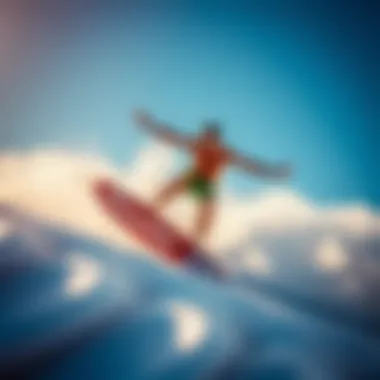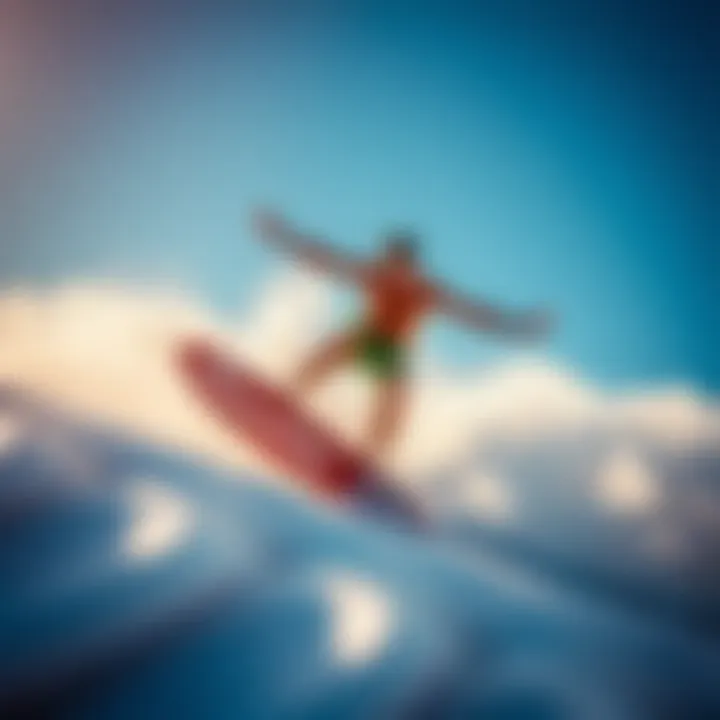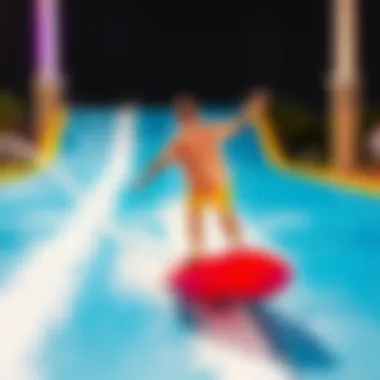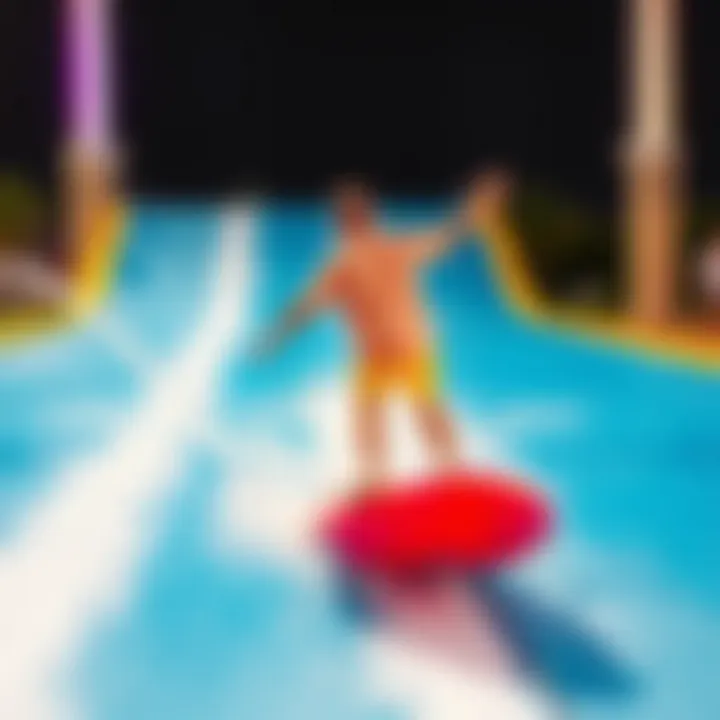Discovering Flowrider Surfing: Ultimate Guide for Enthusiasts


Intro
Flowrider surfing brings a unique twist to the world of surfing. Unlike traditional wave riding, where surfers chase after ocean swells, Flowrider allows individuals to experience the thrill of surfing on a stationary, artificial wave. This sport has gained traction among adventure enthusiasts who seek a blend of fun, skill, and community. But what makes Flowrider particularly appealing?
The allure lies not just in the adrenaline rush but also in the accessibility it offers. Aspiring surfers no longer need to travel to coastal hotspots; Flowrider installations can be found at water parks, resorts, and even sporting complexes worldwide. This means that whether you're a seasoned pro or a rookie eager to try your hand at balancing on a surfboard, there's usually a Flowrider setup nearby ready to welcome you.
This guide aims to break down the fundamentals of Flowrider surfing. We’ll unravel techniques that will elevate your surfing game, spotlight essential equipment you’ll need, and discuss safety measures critical for enjoying this exhilarating sport. Additionally, we’ll highlight renowned locations ideal for trying out Flowrider surfing along with profiles of athletes who exemplify excellence in this field. By diving deep into these areas, this article will equip both newbies and experienced surfers with the knowledge they need to fully embrace Flowrider surfing.
Understanding Flowrider Surfing
Flowrider surfing is more than just a thrilling water sport; it’s a unique blend of fun, adventure, and athleticism. Understanding Flowrider surfing is crucial for anyone keen on diving into this exhilarating activity. It offers a fresh perspective on surfing, making the waves accessible to individuals who might not be able to catch a swell in the ocean or who simply seek a thrilling experience without the complexities that come with traditional surfing.
This sport appeals particularly to thrill-seekers and extreme sports enthusiasts, presenting a controlled environment where surfers can practice and refine their skills. Additionally, Flowrider setups often attract groups of friends and families, fostering a community vibe that contributes to its growing popularity.
Key elements of Flowrider surfing include its innovative design that simulates ocean waves through a powerful water current, providing a continuous surfable surface. This makes it an excellent option for novices and experienced surfers alike. The ability to practice anywhere with a setup—be it an indoor or an outdoor venue—demonstrates the versatility of Flowrider setups.
Benefits of grasping the foundational concepts of Flowrider surfing extend beyond surface-level enjoyment. Understanding this sport allows participants to maximize their experience, ensuring safety while optimizing their performance. Moreover, knowledge about the mechanics and operations within Flowrider surfing can encourage more thoughtful engagement, enhancing overall enjoyment and skill progression.
The Concept of Flowrider
At its core, the concept of Flowrider revolves around creating a wave-like effect through the propulsion of water. Imagine standing on a board, gliding effortlessly as a smooth current flows beneath you—a synthetic wave generated by high-powered water jets. This setup makes it possible for riders to perform tricks, carve turns, and experience the joy of surfing without the challenges posed by natural ocean waves.
Flowrider technology consists of a surfable surface, usually made of a soft and forgiving material designed to enhance safety for beginners. The technology is gamified in such a way that anyone—from a toddler to someone in their golden years—can take part, making it a universally appealing sport.
Origins and Evolution of Flowrider
The roots of Flowrider surfing can be traced back to the late 20th century when water parks and resorts began to recognize the untapped potential for surf-like attractions. The initial concept was simple: harness water currents to create a recreational surfing experience. Over the years, this idea evolved into the sophisticated Flowrider setups we see today, facilitating both learning and showcasing talented surfers.
The Flowrider has traveled far from its beginnings; once limited to niche water parks, it now enjoys broad acceptance in various locales, including clubs, resorts, and independent flow facilities. As interest in extreme sports surges globally, the Flowrider phenomenon stands to gain more followers, evolving not just as a sport but as a cultural touchstone for adventure enthusiasts.
"Discovering Flowrider surfing is akin to finding the golden ticket of thrill-seeking—unmatched excitement without the need for a vast ocean or fear of unpredictable waves."
Understanding the evolution of Flowrider surfing illuminates just how far this sport has come. This awareness can drive the desire to participate in and promote the sport, creating a more informed and enthusiastic community.
The Mechanics of Flowrider Surfing
Understanding the mechanics of Flowrider surfing is paramount for those who wish to dive into this exhilarating sport. The Flowrider is not just a passing fad; it’s a unique water-based experience that combines aspects of traditional surfing with a fresh twist that appeals to a wide range of participants. By grasping its underlying mechanics, surfers can maximize their enjoyment and skills on this artificial wave, ensuring safety and efficiency in their riding techniques.
How the Flowrider Works
At its core, the Flowrider operates on a simple yet effective principle: a continuous sheet of flowing water that mimics the natural forces of the ocean. The setup typically consists of a shallow deck that unleashes water at high velocity. Riders must find their balance—almost like a tightrope walker—while navigating this rushing water. The water flows over an inclined surface, creating a wave-like effect, allowing surfers to ride and perform tricks.
- Key Components:
- Water Source: High-pressure pumps create the necessary flow rate, pushing a steady stream of water through the surface.
- Surface: A slick material designed for traction underfoot and to mimic real wave dynamics.
- Angle of Inclination: The steepness of the setup affects wave size and difficulty level, making it suitable for all skill levels.
Many beginners might find it daunting initially. Yet, thanks to the grace of physics and a dash of engineering, once you get your footing, it's like dancing on water, albeit with a touch of unpredictability! Each rider's interactions with the board and the water create variations that make every session unique, enhancing the appeal of Flowrider surfing.
Types of Flowrider Setups
Flowrider setups can vary significantly depending on the venue and design preferences. This variety allows enthusiasts to choose environments that best suit their desired experience and skill level. Here are some common types of Flowrider setups:
- Single Flowrider: A single lane ideal for personal practice. You have the space to hone your skills and progress at your own pace.
- Dual Flowriders: These setups allow for competition or partnership, making it a social experience while also introducing a friendly rivalry.
- Flowbarrel:
Unlike the traditional Flowrider, the Flowbarrel is designed to replicate a more advanced wave experience, offering barrel rides for those looking to push the limits of their skills.
In summary, whether you're just starting or looking to refine advanced techniques, selecting the right Flowrider setup is critical. It profoundly influences your learning curve and overall enjoyment of the sport. The diversity in setup types ensures that there is something for every surfer, whether they seek relaxation or adrenaline-fueled excitement.
"The beauty of Flowrider surfing lies not only in the challenge of staying upright but also in the camaraderie among riders who share the wave—and often the wipeouts."
Equipped with knowledge about how Flowriders work and the types available, enthusiasts are well-prepared to embark on their surf adventures. Understanding these mechanics not only enriches the riding experience but also fosters a deeper appreciation for the artistry involved in this sport.


Finding Flowrider Surfing Locations Nearby
Locating Flowrider surfing venues is an essential aspect of fully embracing this thrilling sport. Since Flowrider surfing requires specialized facilities to create the artificial waves, enthusiasts must know where to seek these locations. Whether you're a newcomer eager to try your hand at surfing or a seasoned rider looking for the next big wave, understanding how to find nearby Flowrider setups can make all the difference in your experience.
One key benefit of discovering local Flowrider facilities is that it encourages participation in a growing community of surf lovers. It can lead to friendships, shared tips on techniques, and even the possibility of meeting fellow riders who might just push you to improve your skills. Moreover, visiting various venues also allows surfers to experience different wave configurations and setups, offering a broader range of practice to elevate one's abilities.
In addition, by knowing where Flowriders are located, surfers become more capable of planning trips or outings that combine other recreational activities, creating a fulfilling day filled with adventure and excitement!
Researching Local Venues
When it comes to diving into the world of Flowrider surfing, research is paramount. First off, you'll want to tap into online resources such as Google Maps or local tourism websites. You might find gem spots right under your nose, not to mention a few unexpected facilities that could surprise you.
Social platforms, like Reddit and Facebook, can also yield valuable information. Participating in groups focused on surfing or extreme sports allows riders to share experiences regarding specific Flowrider venues. You can often find firsthand accounts detailing which places are worth your time and which ones might not live up to the hype.
Also, don't discount good ol' word of mouth. Chatting with friends or fellow riders can uncover hidden treasures. Ask around; someone may have a favorite spot that’s not widely advertised but is absolutely worth checking out. Keep in mind, it’s not just about the surfing; many venues offer a lively atmosphere with events and community engagement that can enhance your entire Flowrider adventure.
Recommended Flowrider Facilities
After diligent research, you may find several Flowrider facilities that stand out for their impressive setups and community vibes. Here are a few suggestions:
- The Flowrider at the Mall of America - A remarkable indoor surfing experience, perfect for when the weather is less than favorable.
- O Waterpark - Located in many cities, this facility typically includes various water attractions, providing ample opportunity to hone your Flowrider skills.
- Incredible Waves - A dedicated Flowrider park that promises well-maintained equipment and a welcoming atmosphere.
- Resorts with Flowriders - Many resorts across the US incorporate Flowriders into their water sports offerings, creating a relaxing vacation vibe while still focusing on active fun.
"Combining surfing with community engagement makes Flowrider a unique experience, different from traditional surfing."
Researching and visiting these facilities will allow you to fully immerse yourself in the exhilarating world of Flowrider surfing. Don't hesitate to reach out or plan a visit to any of these venues — your next ride awaits!
Techniques for Successful Flowrider Surfing
Engaging with Flowrider surfing is not merely about enjoying the rush; mastering the techniques involved can vastly enhance the experience. Understanding various techniques helps both beginners and experienced surfers navigate the nuances of Flowrider setups. Proper technique can not only maximize enjoyment but also reduce the risk of injury. By honing these skills, anyone can elevate their surfing to new heights—both figuratively and literally.
Basic Riding Techniques
Before diving into the thrill of advanced tricks, it's essential to get the basics right. Here are some key points that will set a strong foundation:
- Proper Stance: Stand with your feet shoulder-width apart. Keep your knees slightly bent and your body relaxed. This positioning enables better balance and control.
- Weight Distribution: Shift your weight towards your heels or toes to steer effectively. This is crucial for making sharp turns while staying stable. Over-leaning can lead to wipeouts, so practice subtle shifts until it feels natural.
- Paddle for Momentum: Begin by using arm strokes to create initial movement. This helps build momentum before you start standing up, which is vital for maintaining speed on the Flowrider.
- Look Ahead: Keep your gaze focused in the direction you want to go. This helps in effectively planning your moves and avoiding obstacles. Your body naturally follows where your eyes are directed.
- Keep Movements Smooth: Abrupt movements might throw you off balance. Instead, focus on making smooth transitions in stance and weight shifts to maintain flow.
By mastering these foundational techniques, beginners can gain the confidence needed to tackle the flow and enjoy the ride without fear of face-planting.
Advanced Maneuvers to Master
Once you feel comfortable with the basic techniques, it’s time to step up your game and take on more advanced maneuvers. These moves not only demonstrate skill but also impress fellow surfers:
- The Duck Dive: This maneuver allows surfers to dive under a wave to avoid falling off. Practice this technique by crouching down on your board and pushing off into the water to slip beneath waves when encountering higher flows.
- 360 Spins: This trick involves using your body and board to spin in a complete circle while maintaining your footing. Begin by gaining speed, lean into the spin, and focus on controlling your center of gravity.
- Air Tricks: Learning to catch air can be exhilarating. Start with basic jumps, then progress to grabs—a move where you grab your board mid-air. Focus on planting your body low as you prepare for the jump, then launch off with confidence.
- The Snap: Flicking your board back sharply while riding up the flow creates a stylish display that’s sure to draw admiration. It's essential to time this move closely with the wave's break to achieve lift without losing control.
- Inward Spins: Rather than basic spin-outs, attempt inward spins where you pull your board in towards your body while rotating. This requires a strong core and quick reflexes.
"Mastering maneuvers in Flowrider surfing not only impresses others but also deepens your understanding of flow dynamics."
Incorporating these advanced techniques into your arsenal requires time, patience, and plenty of practice. As you execute these moves confidently, your enjoyment of Flowrider surfing will increase alongside your skill level. Remember, every surfer starts somewhere, and persistence is key to unlocking your potential on the waves.
The Essential Gear for Flowrider Surfing
Flowrider surfing is not just an exhilarating experience; it demands the right gear to ensure both performance and safety. Choosing the appropriate equipment can significantly impact your ability to catch those perfect waves and enjoy the thrill of the ride. Without proper gear, the joy of surfing can quickly turn into a battle against the currents, which is something no thrill-seeker wants. In this section, we'll explore the crucial components of gear needed for Flowrider surfing, delving into both boards and protective equipment.
Choosing the Right Board
When it comes to Flowrider surfing, your board is your lifeline. Selecting the right type of board is essential for your performance and comfort. Flowboards are specifically designed for the unique mechanics of the Flowrider, which differs from traditional surfing. These boards are usually shorter and feature a flatter base, allowing for more fluid movements and greater maneuverability on the artificial wave surface.
Key Factors to Consider:
- Board Size: A shorter board often offers better control, especially for tricks, while a longer board can provide stability. Beginner riders may prefer longer boards to help maintain balance as they find their footing.
- Material: Most flowboards are constructed using synthetic materials that ensure durability and lightweight characteristics. Look for boards that resist damage from impacts, as it's not uncommon to take spills when you're mastering new techniques.
- Fin Configuration: Some boards come with fins, while others are finless. Fins can aid in grip and stability but may restrict some lateral movement, so pick what aligns better with your riding style.
- Grip and Padding: Ensure the board has adequate grip to prevent slipping while riding. A well-padded surface is also beneficial to minimize discomfort from falls.
Recommendations:


- Brands like FlowRider, Liquid Force, and Shred Stixx offer a range of boards catering to different skill levels.
- It's recommended to try out various boards at rental facilities to determine what feels best for you before making a purchase.
Protective Equipment Recommendations
Safety often takes a backseat when adrenaline is pumping, but don’t let that happen while Flowrider surfing. Protective gear is your first line of defense against the inevitable mishaps that can occur on the water.
Essential Protective Gear:
- Helmet: This is non-negotiable. A snug-fitting helmet designed for water sports will safeguard your head from potential injuries during falls.
- Wetsuit: While optional, a wetsuit can offer warmth and additional protection in cooler waters. It also acts as a second skin against abrasions during spills.
- Wrist Guards: These help prevent wrist injuries, which are common during falls or when attempting new maneuvers. Look for guards that allow for movement without being restrictive.
- Knee Pads: Just as wrist guards are vital, knee pads protect your knees from impacts and abrasions when taking a tumble.
- Footwear: Synaptic water shoes or thick-soled sandals can provide grip and prevent foot injuries.
“Investing in safety gear is just as important as your board. Don’t skimp on your safety—save your thrills for the waves!”
Final Thoughts on Gear:
To maximize your Flowrider experience, remember that the right gear not only enhances performance but also elevates your safety. Take the time to research and try different options, ask fellow surfers for their opinions, or delve into forums like Reddit to gather insights. Always prioritize your equipment as not only your tools, but your trusted allies on this thrilling adventure.
By being well-equipped, not only will you ride the waves with confidence, but you’ll also enjoy smoother sailing as you navigate through the invigorating world of Flowrider surfing.
Cultural Aspects of Flowrider Surfing
Flowrider surfing transcends mere sport; it's a vibrant subculture that fosters camaraderie, creativity, and innovation. This section invites you to dive deeper into the cultural elements that paint the picture of Flowrider surfing, making it a fascinating landscape filled with community spirit and competition.
The Flowrider Community
At the heart of Flowrider surfing lies a community that is as eclectic as they come. Whether you're buzzing with excitement over your first ride or you're a seasoned surfer honed on the waves, there's a place for everyone here. The inclusive vibe draws people from all walks of life—young thrill-seekers, experienced surfers, and even those who simply cheer from the sidelines. This blend creates an environment where friendships often blossom and shared experiences ignite stories that last a lifetime.
Events such as local meets and community gatherings play a pivotal role in strengthening this bond. Participants often gather at various venues, exchanging tips, tricks, and tales of their adventures. One popular social medium where this community thrives is Reddit, where discussions unfold about techniques, gear recommendations, and experiences at different Flowrider locations. Engaging with the community helps newcomers feel welcomed and supported, easing them into the sport with encouragement and shared enthusiasm.
Moreover, the culture surrounding Flowrider surfing accommodates artistic expression, particularly through the exchanging of unique riding styles and personal flair. Riders often strive to develop an individualistic approach to their surfing, showcasing their personality on the flowboard. This aspect of creativity fosters a sense of belonging—as surfers find their tribe and form lasting connections.
Events and Competitions
Flowrider surfing thrives on events and competitions that galvanize the community. These gatherings serve as sweet spot for showcasing talent, creativity, and, of course, a little friendly rivalry. Competitions can vary in scale, from casual local contests to more serious championships that attract participants from around the globe.
Events like the Flowrider World Championship not only celebrate existing talents but also attract new enthusiasts to the sport. Competitions often include various categories, such as freestyle riding, tricks, and overall performance. Riders are judged on creativity, skill, and style, which pushes all participants to continuously improve and innovate.
These contests are not just a display of skill but a celebration of the Flowrider culture itself. They are opportunities for outdoor fun, with food stalls, music, and booths that showcase local brands and talent. The result is a lively atmosphere that extends beyond surfing—bringing in elements of festival culture.
In summary, the cultural aspects of Flowrider surfing significantly contribute to its allure and charm. It fosters a tight-knit community that celebrates inclusiveness, personal expression, and competitive spirit while paving the way for the sport’s continued growth. By engaging with the community and participating in events, enthusiasts don’t just surf; they dive into a lifestyle that values connection and creativity.
Safety Considerations for Flowrider Enthusiasts
Engaging in Flowrider surfing is not only thrilling but also comes with its fair share of risks. Understanding safety considerations is paramount for a rewarding experience. The importance of safety in Flowrider surfing cannot be overstated; it not only ensures personal safety but also makes for a less stressful environment for everyone involved. Knowing how to protect yourself while surfing the endless wave adds a level of confidence that can significantly enhance performance. Let's dive into the key elements of safety that every Flowrider enthusiast should consider.
Understanding Risks Involved
Like any extreme sport, Flowrider surfing poses certain risks. These can range from minor injuries to more serious accidents. Here are some of the risks that surfers might face:
- Slips and Falls: The artificial surface could be slick, especially for beginners getting their balance. Falling might lead to scrapes or bruises.
- Collision Risks: In crowded venues, there's a chance of bumping into others who might be surfing near you, so maintaining spatial awareness is crucial.
- Overexertion: Pushing oneself too hard can lead to fatigue, increasing the risk of injury. It's best to know your limits.
- Equipment Malfunctions: Issues with the surfboard or the Flowrider machine itself could lead to accidents. Checking equipment before use can prevent such situations.
It’s vital for surfers to approach this sport with respect for the elements at play, recognizing that a few quick misjudgments can lead to injury or worse. The key lies in being aware of surroundings and personal readiness, ensuring the ride remains exciting and free from harm.
Best Practices for Safety
To enjoy Flowrider surfing without grief, implementing best safety practices is essential. Here are some straightforward yet effective tips that can mitigate risks:
- Wear Appropriate Gear: A rash guard or wetsuit not only protects against abrasions but also keeps the body warm. Don't forget proper footwear, as it can help with grip.
- Familiarize Yourself with the Flowrider: Before jumping in, take a moment to observe. Understanding how the wave functions ensures you're mentally prepared when it's your turn.
- Start Slow: For beginners, it’s tempting to try advanced maneuvers. Instead, focus on mastering the basics first. This builds a solid foundation and prevents unnecessary accidents.
- Stay Hydrated and Rested: Thrill-seeking can dehydrate you quickly. Drink water regularly and take breaks to avoid exhaustion, which could harm your focus.
- Follow Venue Rules: Mind the instructions given by staff. These guidelines are there for a reason, ensuring everyone stays safe while enjoying the ride.
"Safety is not just a set of rules, but a mindset to cultivate on the waves of the Flowrider."
These best practices form the backbone of a safe surfing experience and provide a framework to enjoy the adrenaline rush of Flowrider surfing without incurring unwanted injuries. By understanding the risks and committing to safety, you pave the way for countless exhilarating rides.


The Future of Flowrider Surfing
The landscape of Flowrider surfing is evolving rapidly, and understanding its future is vital for enthusiasts and newcomers alike. With advancements in technology and growing popularity, Flowrider surfing is poised to take its place as a staple in the world of extreme sports. The sport, which mimics the sensation of ocean surfing but in a controlled environment, attracts a diverse crowd, from casual thrill-seekers to dedicated athletes.
Looking ahead, several critical elements will shape the progression of Flowrider surfing, including technological innovations, environmental considerations, and the continued cultivation of a passionate community.
Innovations in Flowrider Technology
A prime contributor to the future of Flowrider surfing lies in the innovations in technology associated with the sport. These improvements can enhance the overall experience and open new avenues for surf techniques.
- Improved Wave Generation: Newer Flowrider models are being designed to produce more realistic wave patterns. These advancements not only make surfing more enjoyable but also increase accessibility for both novice and experienced surfers, enabling them to practice various techniques safely.
- Smart Sensing Systems: Equipped with sensors, modern Flowrider setups can now analyze a surfer's movements. This data can provide instant feedback and help riders improve their skills in real-time. Such technology fosters a learning environment that was previously limited or impractical in traditional surfing.
- Sustainable Practices: As environmental concerns grow, the Flowrider industry is increasingly adopting eco-friendly materials and processes in construction and maintenance. These practices not only reduce the sport's carbon footprint but also appeal to environmentally conscious surfers.
"As Flowrider surfing continues to integrate technology and sustainability, it has the potential to attract a wider audience while preserving the joy of the surf experience."
Predicted Trends in the Sport
Understanding predicted trends in Flowrider surfing is crucial for anyone looking to immerse themselves in this exhilarating activity.
- Increased Popularity in Urban Areas: As cities expand and space becomes limited, urban Flowrider parks are likely to spring up, bringing this unique surfing experience to a broader audience. These parks can serve as accessible venues for those who may not have the opportunity to travel to coastal areas.
- Growth of Competitive Events: With the rise in interest, more competitive events may emerge, ranging from local competitions to international championships. This trend can further professionalize the sport, drawing in sponsorship and providing an avenue for aspiring athletes to showcase their skills.
- Fusion with Other Extreme Sports: The future of Flowrider surfing may also see a blending of disciplines. For example, integrating elements of snowboarding and skateboarding into Flowrider events could lead to more dynamic competitions, attracting fans from various action sports communities.
Comparing Flowrider to Traditional Surfing
The allure of both Flowrider and traditional surfing rests on their ability to harness the power of water, creating an exhilarating experience for enthusiasts. While they share common ground, each offers unique aspects on the water. Understanding these differences and similarities can greatly influence your choice as you embark on your surfing journey.
Similarities and Differences
At first glance, Flowrider and traditional surfing may seem like two peas in a pod. Both sports require balance, coordination, and an intimate understanding of wave dynamics. However, the underlying mechanics and experience can be strikingly different.
- Wave Simulation vs. Natural Waves: Flowrider utilizes a continuous sheet of flowing water, mimicking the feel of a wave but with more predictable conditions. This contrasts with traditional surfing, where the unpredictable nature of ocean waves plays a significant role in the experience.
- Accessibility: Getting into Flowrider surfing often needs less commitment and time compared to traditional surfing. Many Flowrider venues are located in urban areas or resorts, making them easier to access without the need for long trips to the coast.
- Riding Styles: In Flowrider, riders typically engage in shorter, more varied rides focused on tricks and spins. Traditional surfers, on the other hand, often chase waves that can last for minutes, emphasizing wave riding and carving techniques.
Key Elements to Consider:
- Equipment Needs: Flowriders often have specific boards designed for the flow surface, while traditional surfers have a wider range of board styles based on wave conditions.
- Learning Curve: Beginners might find Flowrider easier to learn due to its more forgiving setup. In contrast, mastering traditional surfing can be a frustrating but rewarding process, especially when facing ocean surf.
As you weigh these aspects, consider what factors resonate most with your surfing ambitions.
Hybrid Experiences and Innovations
In the pursuit of finding the sweet spot between Flowrider and traditional surfing, hybrid experiences are surfacing. Some facilities are introducing innovative setups that blend the two styles, allowing surfers to tap into both worlds.
- Artificial Wave Pools: These setups create genuine waves paired with Flowrider technology, letting riders experience the thrill of both styles in one session. Brands like Wavegarden have been pioneers in this aspect, bringing waves that can be tailored in shape and intensity, addressing the dynamics crucial for both Flowrider and traditional surfing.
- Adventure Parks: A rise in water parks offering both Flowrider sections and traditional wave pools is presenting surfers with multiple options. Places like Surf Snowdonia in Wales reflect this trend, enabling visitors to experience the learning curve towards ocean surf in a controlled environment.
"Innovation is the bridge that connects your passion for surfing, whether on a Flowrider or catching waves at the beach."
These hybrid setups are not only expanding opportunities for thrill-seekers but also enriching the surfing community by fostering connections among enthusiasts from different backgrounds. Together, they create a more inclusive atmosphere, making the sport accessible without sacrificing the excitement that both mediums provide.
As you explore these innovations, remember that both Flowrider and traditional surfing command a respect for the water, forging a community where passion can flourish.
Getting Started with Flowrider Surfing
Diving into Flowrider surfing is like opening a door to an exhilarating world where the thrill of riding a wave blends seamlessly with innovation and community. The initial experience can be daunting, especially for newbies, but the rewards of mastering this artificial surfing phenomenon are well worth it. Understanding the ins-and-outs of getting started helps to remove any trepidation and ensures a more enjoyable experience.
Beginner's Guide to Flowrider
When you take your first steps onto the Flowrider, it’s crucial to start simple.
- Familiarization with the Equipment: Before you hit the waves, even if they're artificial ones, it’s necessary to become acquainted with the board. Generally, Flowrider boards tend to be shorter and more forgiving than traditional surfboards, making them perfect for beginners.
- Safety First: Wearing a life vest can never be stressed enough. The flowing water might seem harmless, but having that safety equipment can give the beginner peace of mind.
- Body Position Basics: Stand with your feet shoulder-width apart, staying low, and keeping your knees bent. This posture lowers your center of gravity, making you more stable. Maintaining balance is key; think of it like riding a bike — once you find your balance, you're halfway there.
- Start Off Slow: Begin with some simple rides facing forward. As you get comfortable, you can play with shifting your weight from heel to toe, triggering the board to pivot and maneuver.
- Observe and Learn: Watch those who have been riding for a while. YouTube and social media sites often have gems of wisdom hidden in action. Observation can enhance learning significantly.
It’s a rollercoaster of fun but manageable with practice and patience. Don’t be too hard on yourself; everyone eats sand at first!
Intermediate Skill Development
Once you've mastered the basics, it’s time to level up your skills. Intermediate surfers can explore a range of maneuvers and techniques that bring about a new sense of freedom on the Flowrider.
- Carving Turns: Start bending your knees and leaning into your turns. Carving allows you to modify your line and adds flair to your ride. Experiment with your weight shifts more dynamically; the board responds to your body language.
- Basic Tricks: When comfortable, start trying out simple tricks like 180 spins or even a knee drop. The sensation of flipping the board will send your adrenaline surging.
- Ride Switch: Riding switch means positioning yourself in reverse. This enhances your adaptability and maneuvering on the board and keeps the experience fresh and exciting.
- Balance Drills: Incorporate balance training off the Flowrider as well. Balance boards or even yoga can be tremendously helpful in enhancing your stability and focus.
- Join a Community: Connecting with fellow Flowrider enthusiasts can offer invaluable tips. Websites like reddit.com host forums where you can ask questions and share experiences.
Honing these skills not only makes you a better surfer but also deepens your appreciation for the sport's nuances. Embrace each challenge, and remember, every drop is a lesson waiting to be learned.







